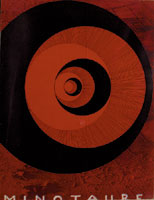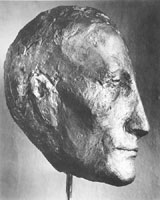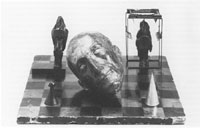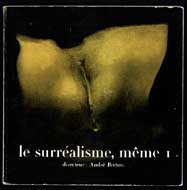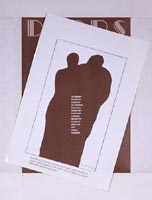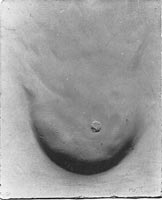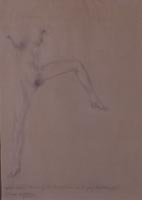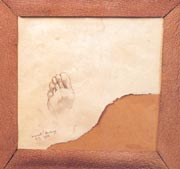The subsequent paper is based on parts of a lecture first held at a three-day Marcel Duchamp symposium, which, accompanied by a small exhibition of works by the artist from the museum’s own collection, took place between November 23-25, 2001, at the Hessisches Landesmuseum Darmstadt, Germany. What follows is intended to highlight the significance of Duchamp’s 1945 window display of Breton’s second and expanded edition of art theoretical writings, ” Le Surréalisme et la Peinture,” (Fig.1) for the production of his last major work, Given: 1. The Waterfall/2. The Illuminating Gas (Figs. 2 and 3). In the process, I attempt to predate Duchamp’s active involvement with this work and to shed some new light on the relationship between Marcel Duchamp and Maria Martins, his lover at the time, as well as Enrico Donati and Isabelle Waldberg, both of whom were involved with the construction of the shop window display. In the process, a new work by Duchamp will be introduced. In addition, the overall significance of the art dealer Julien Levy and René Magritte’s painting Le Modèle Rouge (1935) (Fig. 4) for all of the above shall be examined.
click images to enlarge
- Figure 1
- Figure 2
- Marcel Duchamp, Window
Display for André Breton’s
Le Surréalisme et la Peinture, 1945 - Marcel Duchamp, Given:
1. The Waterfall/2. The
Illuminating Gas, 1946-1966 (outside view)
click images to enlarge
- Figure 3
- Figure 4
- Marcel Duchamp, Given:
1. The Waterfall/2. The Illuminating
Gas, 1946-1966 (inside view) - René Magritte, Le Modèle
Rouge, 1935
click to enlarge

Figure 5
Isabelle Waldberg, Drawing
of Brentano’s Window
Display, 1945
On November 10th, 1945, the Swiss artist Isabelle Waldberg included a drawing in one of her many letters to her husband Patrick, living in Paris at the time. “Yesterday morning, we did the window at Brentano’sSurréalisme et la peinture,” she writes (1) . “Marcel naturally did everything, all design and execution. Here’s a drawing of it:” (Fig. 5)
Within the drawing, Waldberg points out various objects that can be seen from the perspective of a full frontal view of the window display. On the left is a “chicken wire mannequin bought ready-made,” on the right are “boots with toes painted by Donati.” In the center, towering above the “books” is “an object by me underneath the tent.” She defines the tent as “old paper from M.’s studio en chute.”
“chicken wire mannequin bought ready-made”
click to enlarge

Figure 6
Marcel Duchamp, Cover for
VVV Almanac, 1943 (detail)

Figure 7
Frederick Kiesler and Marcel
Duchamp, Twin-Touch-Test (last page of
VVV), 1943
Two small circles within the drawing by Isabelle Waldberg define the protruding breasts of the chicken wire torso, yet from the remaining photograph of the window display it is impossible to tell whether the mannequin is feminine or masculine. In any case, only two years before, for the back cover of VVV (New York, nos. 2-3, March 1943) André Breton’s Surrealist publication in exile, Duchamp had designed a die-cut woman’s profile into which chicken wire was inserted (Fig.6). This see-through miniature torso was to be used for the Twin-Touch-Test, explained on the magazine’s last page (Fig.7): “Put the magazine flat on a table, lift back-cover into vertical position, join hands on both sides of screen, fingertips touching each other and slide gently along screen towards you.” The goal was to experience an “unusual feeling of touch” that the readers were asked to share with VVV. A double-exposure photograph of a slightly ecstatic looking Pegeen Vail (Peggy Guggenheim’s daughter) (2) demonstrated the Twin-Touch-Test while the editors announced a total of five prizes for the best submissions.
The VVV design would not be the only time that chicken wire was to appear in Duchamp’s oeuvre. In 1962, for the exhibition of Surrealist Intrusion in the Enchanter’s Domain, (D’Arcy Galleries, New York, November 28, 1960 – January 14, 1961) Duchamp installed a surrealist environment for the show (he also designed the catalogue) involving many rooms. In one of them Duchamp used a cupboard to house three white chickens. Lit by a green light, a sign above the poultry, made of nickel coins, spells: Coin Sale (Fig.8) (3) . Pronounced in French, “coin sale” means “dirty corner,” a derogative term for the female gender. Here, the chicken wire is used to keep the hens in place. A third instance involving chicken wire is Duchamp’s altered Family Portrait of 1964 (Fig.9). When compared to the 1899 original (Fig.10) (4) , it becomes apparent that what is missing in the photomontage are not only members of Duchamp’s family but also the chicken wire fence running behind both sides of the people gathered for the portrait.
click images to enlarge
- Figure 8
- Figure 9
- Figure 10
- Marcel Duchamp, Environment
for the Enchanter’s
Domain (detail), 1960 - Marcel Duchamp,Family
Portrait (1899), 1964 - Duchamp family portrait
of 1899 (photographer unknown)
“books”
Besides at least two other publications displayed in Brentano’s shop window, a minimum of ten copies of Breton’s Le Surréalisme et la Peinture (Fig.11) were either arranged alongside each other at the bottom of the window or were propped upright, showing off the book’s color reproductions of Surrealist paintings (among many more black and white images) (5). First published in 1928 (by Gallimard, Paris), Les Edition Françaises Brentano produced a second, expanded edition of Le Surréalisme et la Peinture in 1945, while André Breton, Surrealism’s founder, was in temporary exile in New York. The book now included his famous observations (pp. 107-124) on Duchamp’s major work The Bride Stripped Bare by Her Bachelors, Even, 1915-23 (Fig.12), the essay having been initially published inMinotaure in 1934 (Paris, 2, 6, Winter 1935, pp. 45-49) for which Duchamp had designed the cover (Fig.13). Earlier in 1945 the essay, originally titled “Phare de la Mariée,” had been published in English as “Lighthouse of the Bride,” in the Marcel Duchamp number of Charles Henri Ford’s magazine View (New York, 5, 1, March 1945, pp. 6-9, 13), for which Duchamp had also designed the cover (Fig.14).
click images to enlarge
- Figure 11
- Figure 12
- Figure 13
- Figure 14
- André Breton, Le Surréalisme et la Peinture (cover), 1945
- Marcel Duchamp, The Bride Stripped Bare by Her Bachelors,
Even (aka the Large Glass), 1915-1923 - Marcel Duchamp, Cover design for Minotaure, 1934
- Marcel Duchamp, Cover design for View magazine, 1945
It may not come as a surprise then, that Duchamp also had a hand in the design of Breton’s new edition of Le Surréalisme et la Peinture. On July 2, 1945, after meeting with Brentano’s publisher Robert Tenger, Duchamp mailed a letter to Elisa and André Breton in Reno, Nevada with suggestions for the cover: “Take the bare feet, Magritte’s shoes. Instead of black, make a print in sanguine on pink paper (or just white). This bloodshot reproduction would be imprinted in the middle of the board and also imprinted your name, the title of the book […] and Brentano’s below”(6). And sure enough, less than half a year later, it is René Magritte’s Le Modèle Rouge (or Red Model) which appears on the cover of Breton’s book (as well as inside the book, between pp. 104-105). The window display even presented a poster of the image (7).
Completed by mid-November 1935, The Red Model, now in the collection of the Musée National d’Art Moderne, Paris, is the replica of an earlier version of the same name and year. In 1936, it was included in Magritte’s first American solo show at Julien Levy’s gallery (January 3 – January 20, 1936). And in 1947, it was sent by Alex Salkin – the painting’s owner since the late 1930s – to the Hugo Gallery in New York, where, most importantly, it was bought by none other than Maria Martins, on the advice of Marcel Duchamp (8). At the time of Duchamp’s design for Brentano’s window display, Maria Martins, the Brazilian Surrealist sculptor and wife of the Brazilian ambassador to the United States, was already engaged in a full-fledged love affair with Duchamp.
“boots with toes painted by Donati”
click to enlarge

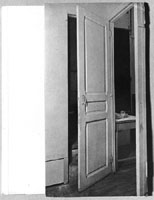
Left: Figure 15
Enrico Donati, Boots for Brentano’s Window Display, 1945
Right: Figure 16
Duchamp, Door: 11 rue Larrey, 1927
The boots to the right of the window did not get lost (Fig.15). In a crude way, they were meant to resemble Magritte’s Red Model, being neither shoes nor feet, both shoe and foot. This sure must have appealed to a gender-hopping Duchamp, art’s patron saint of the eternal and/or. There was, of course, his 1927 door in his tiny Parisian studio-apartment which could be both open and closed at the same time (Fig.16). There was his first major solo-exhibition in 1963, by or of Marcel Duchamp or Rrose Sélavy, his female alter ego (Fig.17); and a later exhibition, Not Seen and/or Less Seen of/by Marcel Duchamp/Rrose Sélavy 1904-64: The Mary Sisler Collection. It turns out that he was deeply involved with Donati’s shoes as well. Besides the known photograph of the window display (9), there is another one from a different angle, reproduced in the French paper La Victoire (New York, no. 47, November 24, 1945) (Fig.18). Underneath the photograph, the following caption appears:
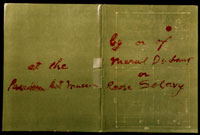

Left: Figure 17
Marcel Duchamp, Cover for Marcel Duchamp: A
Retrospective Exhibition, 1963
Right: Figure 18
Marcel Duchamp, Window Display for André Breton’s
Le Surréalisme et la Peinture, 1945
Window display by Marcel Duchamp and André Breton at Brentano’s bookstore in New York, for “Surrealism and the Painting.” “Magritte Shoes” by Enrico Donati, mask by Isabelle Waldberg, falling paper and studded feet by Marcel Duchamp.
After more than half a century, the quality of the reproduced photograph in the remaining copies of La Victoire is very poor. What can be made out better than from the other photograph are the soles of the feet next to Donati’s, a work by Duchamp only mentioned inVictoire. They are a lot smaller and seem to be feminine in comparison to Donati’s big shoes with protruding plaster toes. Duchamp’s toes appear to be painted on their underside, as if to resemble painted toenails in reverse. They are studded not only at the heel (the heels of a shoe) but also in the center of both soles, with dozens of heads of nails sticking out, altogether arranged in a rectangular shape. While the ensemble with Donati’s shoes might resemble Picabia’s cover for Littérature (Paris, no. 7, December 1, 1922) (Fig.19), it certainly is also reminiscent of Duchamp’s Torture-Morte of 1959 (Fig.20), Duchamp’s enigmatic plaster foot (10).
click to enlarge
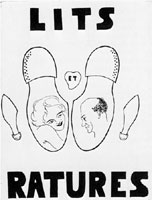

Left: Figure 19
Francis Picabia, Cover for Littérature, 1922
Right: Figure 20
Marcel Duchamp, Torture-Morte,1959
“an object by me underneath the tent”
click to enlarge
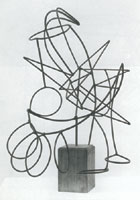
Figure 21
Isabelle Waldberg, Fruit
de Mer, 1943 (1948)
Born in Oberstammheim, Switzerland, in 1911, Isabelle Waldberg stayed in New York between 1941 and 1946. A former member of George Batailles’s secret society Acéphale, she soon joined the Surrealists and met, among others, André Breton, Marcel Duchamp and Max Ernst. At the time she was working on sculptures made of flexible wood sticks (Fig.21) Isabelle Waldberg, Fruit de Mer, 1943 (1948)), some of which were included in Peggy Guggenheim’s famousArt of this Century exhibition in 1944. “Constructions” is the general term Waldberg used for her twisted wooden objects and starting in 1948, she would cast them in iron. It was one of her “constructions” that she used for the window display of Breton’s Le Surréalisme et la Peinture (11) .
When Waldberg returned to Europe after WWII in 1946, Duchamp offered her to stay at his abandoned studio apartment in Paris, at 11 rue Larrey, well-known for the door Duchamp built therein, the one both open and closed at the same time. In 1958, she would cast a small bronze portrait of him (Fig.22) and yet another one in 1978/79, incorportating chess Figures and a device Man Ray used for drying negatives (Fig.23).
click images to enlarge
- Figure 22
- Figure 23
- Isabelle Waldberg, Portrait
de Marcel Duchamp, 1958 - Isabelle Waldberg, Portrait
de Marcel Duchamp, 1978/79
“old paper from M.’s studio en chute“
click to enlarge
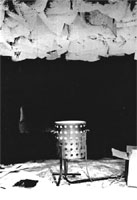
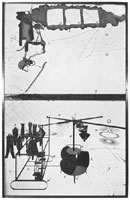
Left:Figure 24
Marcel Duchamp, Twelve Hundred Coal Bags Suspended
from a Ceiling over a Stove (detail),1938
Right: Figure 25
Marcel Duchamp, The Large Glass as reproduced in
Le Surréalisme et la Peinture,1945
The paper en chute casts a shadow that certainly must have been to M. Duchamp’s liking. The light source resting at the bottom of the window display does not look unlike the stove used by Duchamp for another, better-known installation, Twelve Hundred Coal Bags Suspended from a Ceiling over a Stove, which he created for the Exposition Internationale du Surréalisme at the Galerie Beaux-Arts, Paris (January – February 1938) (Fig.24). The “tent” is what Isabelle Waldberg refers to in regard to Duchamp’s old paper suspended from the window’s ceiling, and “en chute” is how she describes it too, as in chute d’eau orwaterfall. “Paper fall” is what Arturo Schwarz picks up from her, comparing the shape to a “wedding veil, which may be a reminiscence of the Bride’s Garment in the Large Glass, 1915-1923, where it appears just above the Waterfall […]”(12).
The Bride’s clothes are never mentioned throughout Duchamp’s notes but are only and first referred to in Breton’s essay Lighthouse of the Bride (1934) (13), where numbers scrawled across a photograph of the Large Glass point out its different components (Fig.25). It is number 13, which, according to Breton (or is it Duchamp?) signifies the location of “Vêtement de la mariée” or clothes of the bride. Of course, it is none other than Le Surréalisme et la Peinture which first makes Breton’s important essay widely available in bookform. But there is much more to it. The “paper fall” might also just be what it resembles most: a waterfall, exactly as in Given: 1. The Waterfall / 2. The Illuminating Gas. Besides the Waterfall, the Illuminating Gas is there, too, resting at the bottom. It is time now to leave Isabelle Waldberg’s description of the window in her letter to her husband Patrick. The remainder of my argument shall inextricably link Duchamp’s window display for Breton’s Le Surréalisme et la Peinture to Given, his last major work.
Julien Levy
We have to return to Duchamp’s shoes. In January 1936, a year after Magritte painted Le Modèle Rouge, it was first exhibited at Julien Levy’s New York gallery. At the end of the same year, Black Sun Press, New York, published Levy’s book on Surrealism. Within this anthology, Levy describes Duchamp as an “ideal shoemaker” (14) who no longer makes shoes but who is still steeped in the act of creation: “A shoemaker makes shoes. A manually proficient shoemaker makes superb shoes. An ideal shoemaker no longer makes shoes, but ideas in his medium. He is divorced from his material objective and, like a madman, he would cut leather and sew leather and choose leathers like a runway engine, except that he has an idea.”(15) Duchamp had stopped painting in 1918, but – besides pursuing a career in chess – never ceased to be
click to enlarge
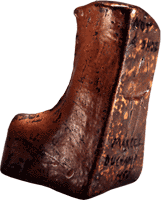
Figure 26
Marcel Duchamp,
Not a Shoe, 1950
involved with art. According to Levy, Duchamp, under the name of Rrose Sélavy […] returned to making shoes, quoting Duchamp as saying: “If it is shoes that you want, I’ll give you shoes that you will admire to such an extent that you will lame yourselves trying to walk in them.” (16)It appears that with Duchamp’s feet/shoes in the shop windows nine years later, this is exactly what he has done.
And it doesn’t stop here: In 1950, Marcel Duchamp presents Julien Levy with a small sculpture made of galvanized plaster, something Levy wouldn’t part with until his death in 1981. The name of the sculpture is Not a Shoe (Fig.26) and the very first of a total of four small objects that would later be determined to be artistic side-products of his secret involvement with the production of Given. No one knew this at the time, of course, and when exhibited, those sculptures were mostly thought of as being “bizarre artifacts”(17). Not a Shoe is the only one not turned into an edition.
click to enlarge
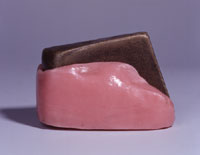
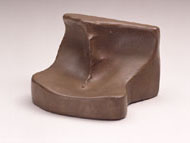
Left: Figure 27
Marcel Duchamp, Wedge of Chastity, 1954 (1963)
Right: Figure 28
Marcel Duchamp, Female Fig Leaf, 1950
Duchamp’s Window Display for André Breton’s
Le Surréalisme et la Peinture (1945) by Girst, Thomas
(with an animation by Slawinski, Robert)
“old paper from M.’s studio en chute“
The paper en chute casts a shadow that certainly must have been to M. Duchamp’s liking. The light source resting at the bottom of the window display does not look unlike the stove used by Duchamp for another, better-known installation, Twelve Hundred Coal Bags Suspended from a Ceiling over a Stove, which he created for the Exposition Internationale du Surréalisme at the Galerie Beaux-Arts, Paris (January – February 1938) (Fig.24). The “tent” is what Isabelle Waldberg refers to in regard to Duchamp’s old paper suspended from the window’s ceiling, and “en chute” is how she describes it too, as in chute d’eau orwaterfall. “Paper fall” is what Arturo Schwarz picks up from her, comparing the shape to a “wedding veil, which may be a reminiscence of the Bride’s Garment in the Large Glass, 1915-1923, where it appears just above the Waterfall […]”(12).
The Bride’s clothes are never mentioned throughout Duchamp’s notes but are only and first referred to in Breton’s essay Lighthouse of the Bride (1934) (13), where numbers scrawled across a photograph of the Large Glass point out its different components (Fig.25). It is number 13, which, according to Breton (or is it Duchamp?) signifies the location of “Vêtement de la mariée” or clothes of the bride. Of course, it is none other than Le Surréalisme et la Peinture which first makes Breton’s important essay widely available in bookform. But there is much more to it. The “paper fall” might also just be what it resembles most: a waterfall, exactly as in Given: 1. The Waterfall / 2. The Illuminating Gas. Besides the Waterfall, the Illuminating Gas is there, too, resting at the bottom. It is time now to leave Isabelle Waldberg’s description of the window in her letter to her husband Patrick. The remainder of my argument shall inextricably link Duchamp’s window display for Breton’s Le Surréalisme et la Peinture to Given, his last major work.
Julien Levy
We have to return to Duchamp’s shoes. In January 1936, a year after Magritte painted Le Modèle Rouge, it was first exhibited at Julien Levy’s New York gallery. At the end of the same year, Black Sun Press, New York, published Levy’s book on Surrealism. Within this anthology, Levy describes Duchamp as an “ideal shoemaker” (14) who no longer makes shoes but who is still steeped in the act of creation: “A shoemaker makes shoes. A manually proficient shoemaker makes superb shoes. An ideal shoemaker no longer makes shoes, but ideas in his medium. He is divorced from his material objective and, like a madman, he would cut leather and sew leather and choose leathers like a runway engine, except that he has an idea.”(15) Duchamp had stopped painting in 1918, but – besides pursuing a career in chess – never ceased to be
click to enlarge

Figure 26
Marcel Duchamp, Not a Shoe, 1950
involved with art. According to Levy, Duchamp, under the name of Rrose Sélavy […] returned to making shoes, quoting Duchamp as saying: “If it is shoes that you want, I’ll give you shoes that you will admire to such an extent that you will lame yourselves trying to walk in them.” (16)It appears that with Duchamp’s feet/shoes in the shop windows nine years later, this is exactly what he has done.
And it doesn’t stop here: In 1950, Marcel Duchamp presents Julien Levy with a small sculpture made of galvanized plaster, something Levy wouldn’t part with until his death in 1981. The name of the sculpture is Not a Shoe (Fig.26) and the very first of a total of four small objects that would later be determined to be artistic side-products of his secret involvement with the production of Given. No one knew this at the time, of course, and when exhibited, those sculptures were mostly thought of as being “bizarre artifacts”(17). Not a Shoe is the only one not turned into an edition.
click to enlarge


Left: Figure 27
Marcel Duchamp,Wedge of Chastity, 1954 (1963)
Right: Figure 28
Marcel Duchamp, Female Fig Leaf, 1950
It most closely resembles theWedge section of the Wedge of Chastity (Fig.27) which in turn relates to the central vertical line of Female Fig Leaf (Fig.28). The latter is believed to be a mock or negative cast of the primary female genitalia, the part most prominently presented to the viewer of Given.
Why present Levy with the first hint of Given? Why not. It was Levy, eventually, who would recall Duchamp’s first mentioning of a similar project. In hisMemoirs of an Art Gallery (1977), he wrote of first meeting Duchamp fifty years earlier, on board of the Paris, a transatlantic steamer taking both from New York to Le Havre, France, in 1927. “Marcel toyed with two flexible pieces of wire, bending and twirling them, occasionally tracing their outline on a piece of paper. He was devising a mechanical female apparatus […], a soft anatomical machine. He said, jokingly, he thought of making a life-size articulated dummy, a mechanical woman whose vagina, contrived of meshed springs and ball bearings, would be contractile, possibly self-lubricating, and activated from a remote control, perhaps located in the head and connected by the leverage of the two wires he was shaping. The apparatus might be used as a sort of
click to enlarge
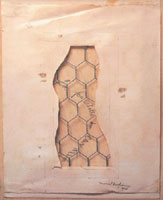
Figure 29
Marcel Duchamp, Boîte-en-Valise
for Julien Levy (X/XX) (detail),1944
‘machine-onaniste‘ without hands. […] ‘The lines of the two wires,’ he went on, ‘when they are shaped to give just the leverage needed and then removed from their function as messengers between the head and vagina, they become abstractions‘” (18). Here is Duchamp playing with wire in 1927. In 1945, there is the chicken wire torso in the window display for Breton’s book. Almost needless to say that Julien Levy’sBoîte en Valise contained the original maquette for Duchamp’s 1943VVV miniature torso made of chicken wire (Fig.29). It has been remarked elsewhere that when Duchamp enclosed the original in hisBoîte for Levy in January 1944, he “added an inscription, written through the chicken wire after assembly: La Fourchette du Cavalier (The Night’s Fork). The Knight’s Fork is a chess position in which the knight attacks two opposing pieces at once. Duchamp’s erotic transposition of this situation needs no further explanation”(19). Duchamp had arranged the writing in a half-circle, leading from the breast of the torso to its lower region, to the female genitalia, or, for that matter, to Not a Shoe, to the “coin sale.”
André Breton
click to enlarge
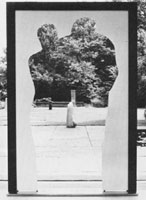
Figure 30
Marcel Duchamp, Door for
Gradiva, 1937 (1968)
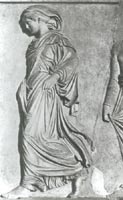
Figure 31
Plaster Relief of Gradiva
We have to return to Duchamp’s shoes. In the window display of 1945, they were neither all feet nor all shoes: Breton and Duchamp had collaborated many times before. Take 1937. Financially down on his luck and struggling to support his firstborn child, Breton was offered a gallery space by a generous friend for a few months. The original glass door (Fig.30) consisted of the incised outline of a couple through which the visitors could enter the gallery at 31, rue de Seine. Or, as Breton himself described Gradiva’s entrance: “You entered the store through a glass door that had been designed and executed by Marcel Duchamp, whose opening silhouetted, as their shadows might, a rather large man and a noticeably smaller and very slim woman, standing side by side” (20).
Breton had borrowed the title of his exhibition space from a book by Wilhelm Jensen (1827-1911) of the same name, in which the archeologist Dr. Norbert Hanold falls in love with a young woman depicted on a Roman plaster relief from Pompeii, now in the collection of the Vatican (Fig.31). The descending female, longingly named Gradiva by the protagonist – originally translating into “she who walks” -, wears a long tunic exposing her beautiful bare feet clad in sandals. The erotically charged space between the sole and shoe is prominently featured throughout Jensen’s short novel written along the theme of cherchez la femme. It was no other than Sigmund Freud, admired by Breton and the Surrealists, who had written a long essay on Jensen’s book, annotating his copy of Gradiva with short notes about the meaning of dreams and foot fetishism (21). Duchamp was no stranger to this part of the female anatomy, as a friend of his remembered him during a tableau vivant at the Arensberg’s a few years after Duchamp’s arrival in New York in 1914: “A young Frenchwoman was reclining on a divan like a virginal Olympia while the male guests took turns stroking parts of her body. Duchamp was devoting himself to her legs, which he caressed with the tips of his fingers. [William Carlos] Williams watched the spectacle in awe: ‘It was something I had not seen before. Her feet were being kissed, her shins, her knees […]'”(22).
Duchamp most certainly knew about Gradiva (23). When a long article on her appeared in the first issue of Le Surréalisme, même (24), it was Duchamp who designed the cover (Fig.32), choosing a photograph of the Female Fig Leaf, with the concave form appearing almost convex, the “coin sale”, the Not a Shoe, in the center. There is yet another hint in all of this. Another version of theGradiva door for Breton’s gallery appeared much later. In 1968, for the announcement of theDoors exhibition at Cordier & Ekstrom, New York (March 19 – April 20, 1968), Duchamp produced miniatures of the door, both on paper and acetate (Fig.33). In addition, he created a “life-size” plexiglass replica of his Gradiva glass entrance. Two years after the completion ofGiven in 1966 and shortly before his death, Duchamp must have been amused at the exhibition’s theme of Doors, fully aware that Given, with its exterior consisting of a massive wooden Spanish door and an archway of red bricks, would be posthumously revealed to the public in the Philadelphia Museum of Art.
click images to enlarge
- Figure 32
- Figure 33
- Marcel Duchamp, Cover
for Le Surréalisme, même, 1956 - Marcel Duchamp, Announcement
for the Exhibition Doors, 1968
Enrico Donati
click to enlarge
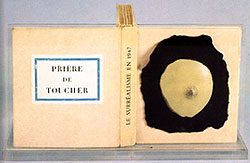
Figure 34
Marcel Duchamp, Cover for
Le Surréalisme en 1947, 1947
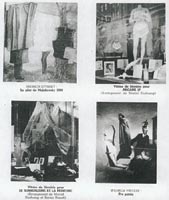
Figure 35
Le Surréalisme en 1947,
Plate XLI, 1947
Not only did Duchamp and Donati collaborate in 1945 (25), but the window display for Breton’s book was the first time that they worked together. Not even two years later, in mid-1947, Donati would assist Duchamp in his cover design for Le Surréalisme en 1947, a major exhibition of the movement held at the Galerie Maeght, Paris (July-August 1947). For each numbered deluxe edition of the catalogue (there were over 1000 of them), Donati and Duchamp would paste pink foam rubber-breasts, surrounded by a rough-edged circle of black velvet (Fig.34).
Within the catalogue, plate XLI depicts four images, of which the lower left is a photograph of Duchamp’s and Donati’s window display of 1945 (Fig.35). The upper right image shows another window design by Duchamp of the same year, while the pictures by Surrealist painters Wilhelm Freddie and Jindrich Styrsky both depict half-hidden women. In Freddie’s painting, the lower half of a what appears to be a clothed female whose body hangs outside a wall opening not unlike the brick wall of Duchamp’s Given interior.
The back cover of Le Surréalisme en 1947 presents a sticker reading Prière de Toucher or “Please Touch.” (We are not too far from Duchamp’s miniature chicken-wire torso of 1943, his Twin-Touch-Test for the back of VVV.) The abandoned plaster model for the breast cover of the catalogue remained in the collection of Enrico Donati for half a century. (It is now at the Philadelphia Museum of Art.) (Fig.36). The model for this and a subsequent plaster was Maria Martins, Duchamp’s intimate friend (26). The breast plasters are linked to the nude torso in Given, for which Maria Martins was the first model. Yet another work by Duchamp was in Enrico Donati’s possession. An unnumbered Boîte-en-Valise, just like Levy’s, including another original art work mounted on the lid’s inside: a scrap of paper with a detailed drawing of the underside of a human foot believed to be that of Maria Martins (Fig.37)(27). In one of Honoré de Balzac’s better-known stories, The Unknown Masterpiece (first published in 1831) (28), the otherwise successful artist Frenhofer struggles for years with a canvas, yet coming up with nothing more than a mass of confused colors. Almost nothing. Amidst the chaos, looking closely, an “enchanting,” “living” and “admirable” female foot can be seen. Though the first studies for Given show a standing female nude with one foot raised at an awkward angle (Fig.38), Duchamp leaves this part of the anatomy out of the final piece (29).
click images to enlarge
click images to enlarge
- Figure 36
- Figure 37
- Figure 38
- Marcel Duchamp,
Plaster Model for Please Touch, 1947 - Marcel Duchamp, Untitled Drawing
for Enrico Donati’s
Boîte-en-Valise,1946 - Marcel Duchamp, Given: Maria,
the Waterfall, and the Illuminating
Gas, 1947
Maria Martins
click to enlarge

Figure 39
Marcel Duchamp, Coffee Mill, 1911
Not only did Duchamp and Donati collaborate in 1945 (25), but the window display for Breton’s book was the first time that they worked together. Not even two years later, in mid-1947, Donati would assist Duchamp in his cover design for Le Surréalisme en 1947, a major exhibition of the movement held at the Galerie Maeght, Paris (July-August 1947). For each numbered deluxe edition of the catalogue (there were over 1000 of them), Donati and Duchamp would paste pink foam rubber-breasts, surrounded by a rough-edged circle of black velvet (Fig.34).
Within the catalogue, plate XLI depicts four images, of which the lower left is a photograph of Duchamp’s and Donati’s window display of 1945 (Fig.35). The upper right image shows another window design by Duchamp of the same year, while the pictures by Surrealist painters Wilhelm Freddie and Jindrich Styrsky both depict half-hidden women. In Freddie’s painting, the lower half of a what appears to be a clothed female whose body hangs outside a wall opening not unlike the brick wall of Duchamp’s Given interior.
The back cover of Le Surréalisme en 1947 presents a sticker reading Prière de Toucher or “Please Touch.” (We are not too far from Duchamp’s miniature chicken-wire torso of 1943, his Twin-Touch-Test for the back of VVV.) The abandoned plaster model for the breast cover of the catalogue remained in the collection of Enrico Donati for half a century. (It is now at the Philadelphia Museum of Art.) (Fig.36). The model for this and a subsequent plaster was Maria Martins, Duchamp’s intimate friend (26). The breast plasters are linked to the nude torso in Given, for which Maria Martins was the first model. Yet another work by Duchamp was in Enrico Donati’s possession. An unnumbered Boîte-en-Valise, just like Levy’s, including another original art work mounted on the lid’s inside: a scrap of paper with a detailed drawing of the underside of a human foot believed to be that of Maria Martins (Fig.37)(27). In one of Honoré de Balzac’s better-known stories, The Unknown Masterpiece (first published in 1831) (28), the otherwise successful artist Frenhofer struggles for years with a canvas, yet coming up with nothing more than a mass of confused colors. Almost nothing. Amidst the chaos, looking closely, an “enchanting,” “living” and “admirable” female foot can be seen. Though the first studies for Given show a standing female nude with one foot raised at an awkward angle (Fig.38), Duchamp leaves this part of the anatomy out of the final piece (29).
click to enlarge
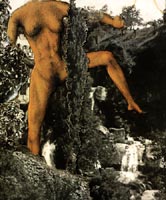
Figure 40
Marcel Duchamp, Study
for Given: 1. The Waterfall /
2. The Illuminating Gas, 1947
It is time now to devote our full attention to the wire sculpture below the “paper fall,” below the “Bride’s veil.” In her letter to her husband, Isabelle Waldberg claimed it was hers and it closely resembles her “constructions” of the time. Yet, as she herself wrote, “Marcel naturally did everything.” Only two years before the first known sketches (Fig.40) (34) of the female Figure for Given and at a time when Duchamp was already involved with Maria Martins, Waldberg’s skeletal wire sculpture bears a close resemblance to the strangely distorted body of Given: the head and one arm hidden, the other outstretched, legs spread far apart, one straight and the other sharply bent at the knee, the triangle of genitalia exposed (35) ::
click for video(QT: 815KB)
download QuickTime Player
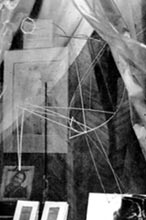
This animation by Robert Slawinski involves the five following unaltered works by Duchamp in the order in which they are listed below: Window Display for Andre Breton’s Le Surréalisme et la Peinture, 1945
Given: Maria, the Waterfall, and the Illuminating Gas, 1947
Study for Given: 1. The Waterfall / 2. The Illuminating Gas, 1947
The Illuminating Gas and the Waterfall, 1948-49 Given: 1. The Waterfall / 2. The Illuminating Gas, 1946-1966.
For Duchamp’s initial introduction of Given in 1945, there could not have been a better setting than a shop window, a work secretly linking Maria Martins to Marcel Duchamp, inextricably bringing the two together in this primal hint at Given‘s appearance, a work that would occupy Marcel Duchamp during the next twenty years until shortly before his death. In a note written in 1913 and published in A l’Infinif, his White Box of 1967, appearing a year after Given‘s completion, Duchamp had unmistakably alluded to the forbidden erotic sensation of the shop-window, the round trip rendez-vous of onlookers and objects, the orgasm through a sheet of glass, the consummation achieved by breaking it, silhouettes emerging.
click to enlarge
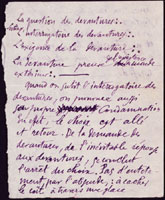
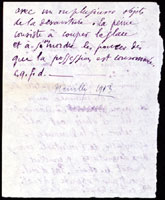
Figure 41 & Figure 42
Marcel Duchamp, Note from A’Linfinitif (White Box),1967 (1913)
The question of shop windows:.
To undergo
The interrogation by shop windows:.
The necessity of the shop window:.
The shop window proof of existence of the world
outside:. –
When undergoing the interrogation
by shop windows, you also pronounce ]
your own judgment Condemnation.
In fact, the choice is a round trip. From
the demands of shop windows, from the
inevitable response to shop windows,
the conclusion is the making of a choice.
No obstinacy, ad absurdum, : in hiding
this coition through a sheet of glass
with one or more of the objects in the
shop window .The penalty consists in
cutting the glass and in kicking yourself
as soon as possession is consummated.
q.e.d. –
Neuilly . 1913 (36)
Notes
 1. In Patrick Waldberg, Isabelle Waldberg: Un Amour Acéphale, Correspondance 1940-1949, Paris: Éditions de la Différence, 1992, p. 331 (translation by Sarah Skinner Kilborne). Brentano’s, a well-known bookstore and publisher at the time, was located in Manhattan at 586 Fifth Avenue.
1. In Patrick Waldberg, Isabelle Waldberg: Un Amour Acéphale, Correspondance 1940-1949, Paris: Éditions de la Différence, 1992, p. 331 (translation by Sarah Skinner Kilborne). Brentano’s, a well-known bookstore and publisher at the time, was located in Manhattan at 586 Fifth Avenue.
click to enlarge
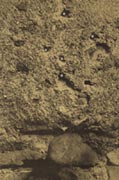
Footnote 2
Marcel Duchamp, Cover for
First Papers of Surrealism, 1942
2.Arturo Schwarz, The Complete Works of Marcel Duchamp (New York: Delano Greenidge, 1999), p. 772.
A year before Duchamp’s back cover for VVV, he had designed the catalogue for theFirst Papers of Surrealism exhibition (New York, October 14 – November 7, 1942), the front cover of which depicts a close-up of bullet traces on the wall of a barn on Kurt Seligmann’s property in Sugar Loaf, New York (see a related article, Shooting Bullets at the Barn, in the Notes-section of Tout-Fait 2, 2000). With chicken and small livestock inside, the only door of the barn was in part made of chicken wire.
 3. Jennifer Gough-Cooper and Jacques Caumont, “Ephemerides on and about Marcel Duchamp and Rrose Sélavy,” in: Pontus Hulten (ed.), Marcel Duchamp: Work and Life (Cambridge, MA: MIT, 1993 [exh. cat.]), n. pag. [28 November 1960].
3. Jennifer Gough-Cooper and Jacques Caumont, “Ephemerides on and about Marcel Duchamp and Rrose Sélavy,” in: Pontus Hulten (ed.), Marcel Duchamp: Work and Life (Cambridge, MA: MIT, 1993 [exh. cat.]), n. pag. [28 November 1960].
 4. I thank Ms. Jacqueline Matisse-Monnier for providing a transparency of the original photograph to the Art Science Research Laboratory.
4. I thank Ms. Jacqueline Matisse-Monnier for providing a transparency of the original photograph to the Art Science Research Laboratory.
click to enlarge
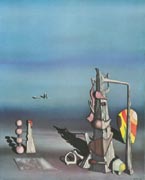
Footnote 5
Yves Tanguy,
En Lieu de Peur, 1941
5. The copy to the lower right of the chicken wire torso appears to be opened to page 176, reproducing Yves Tanguy’s En Lieu de Peur of 1941.
6.Jennifer Gough-Cooper and Jacques Caumont, “Ephemerides,” n. pag. [2 July 1945].
 7. The size of the poster in the display can be determined to be approximately that of the original painting (60 x 45 cm). If it were, in fact, the original and not a reproduction, Isabelle Waldberg would surely have mentioned it in the letter to her husband, although there is a possibility of it having been added later. At the time, however, the painting already was a rather valued work of art and it might not have seemed fit to include it in a window display. (It probably deserves mention that Magritte’s shoes have made it into Frederic Jameson’s influential Postmodernism, or The Cultural Logic of Late Capitalism, Durham: Duke UP 1992 (1990), pp. 1-54. Within the essay, Jameson compares the depiction of shoes in the arts from van Gogh to Warhol, granting Magritte’s shoes that they “take on the carnal reality” of humanism. Van Gogh’s shoes, of course, have been pondered over before by philosophers Martin Heidegger and Jacques Derrida.)
7. The size of the poster in the display can be determined to be approximately that of the original painting (60 x 45 cm). If it were, in fact, the original and not a reproduction, Isabelle Waldberg would surely have mentioned it in the letter to her husband, although there is a possibility of it having been added later. At the time, however, the painting already was a rather valued work of art and it might not have seemed fit to include it in a window display. (It probably deserves mention that Magritte’s shoes have made it into Frederic Jameson’s influential Postmodernism, or The Cultural Logic of Late Capitalism, Durham: Duke UP 1992 (1990), pp. 1-54. Within the essay, Jameson compares the depiction of shoes in the arts from van Gogh to Warhol, granting Magritte’s shoes that they “take on the carnal reality” of humanism. Van Gogh’s shoes, of course, have been pondered over before by philosophers Martin Heidegger and Jacques Derrida.)
 8. David Sylvester (ed.), René Magritte: Catalogue Raisonné, vol. II (London: Menil Collection/Wilson, 1993), p. 207. According to Francis M. Naumann, Maria Martins and Marcel Duchamp were intimately involved throughout all of 1945, with their affair probably having begun as early as 1941 (telephone conversation, March 23, 2000).
8. David Sylvester (ed.), René Magritte: Catalogue Raisonné, vol. II (London: Menil Collection/Wilson, 1993), p. 207. According to Francis M. Naumann, Maria Martins and Marcel Duchamp were intimately involved throughout all of 1945, with their affair probably having begun as early as 1941 (telephone conversation, March 23, 2000).
 9. In a fax of January 19, 2000, Arturo Schwarz claims that the anonymous photograph of the window display reproduced in Duchamp’s Complete Works catalogue was given to him by Breton several years before his death in 1966 and was lost shortly after.
9. In a fax of January 19, 2000, Arturo Schwarz claims that the anonymous photograph of the window display reproduced in Duchamp’s Complete Works catalogue was given to him by Breton several years before his death in 1966 and was lost shortly after.
 10. In this issue of Tout-Fait, note Raymond J. Herdegen’s comparison between Duchamp’s Torture-Morteand a woodcut of Jesus’ studded feet found in an article by Alfred Jarry of July 1895.
10. In this issue of Tout-Fait, note Raymond J. Herdegen’s comparison between Duchamp’s Torture-Morteand a woodcut of Jesus’ studded feet found in an article by Alfred Jarry of July 1895.
 11. In a telephone conversation of April 6, 2000, Isabelle Waldberg’s son, Michel Waldberg, confirmed that like most of the sculptures made in New York, the one used for the window display had apparently been lost.
11. In a telephone conversation of April 6, 2000, Isabelle Waldberg’s son, Michel Waldberg, confirmed that like most of the sculptures made in New York, the one used for the window display had apparently been lost.
 12. Schwarz, Complete Works, p. 772.
12. Schwarz, Complete Works, p. 772.
 13. It was Hector Obalk who first drew my attention to this peculiarity (conversation of November 8, 1999).
13. It was Hector Obalk who first drew my attention to this peculiarity (conversation of November 8, 1999).
 14. Julien Levy, Surrealism, New York: Da Capo, 1995 (1936), p. 16 [original italics].
14. Julien Levy, Surrealism, New York: Da Capo, 1995 (1936), p. 16 [original italics].
 16. Ibid., p. 17 [original italics]
16. Ibid., p. 17 [original italics]
 17. Stuart Preston, “Diverse Facets: Moderns in Wide Variety,” in: The New York Times, December 20, 1953, sect. 10, p. 12.
17. Stuart Preston, “Diverse Facets: Moderns in Wide Variety,” in: The New York Times, December 20, 1953, sect. 10, p. 12.
click to enlarge
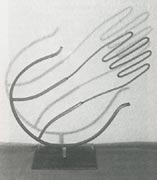
Footnote 18
Marcel Duchamp (?), Porte-Gants, 1927
18. Julien Levy, Memoirs of an Art Gallery, New York: Putnam, 1977, p. 20 [original italics]. The quotes are from the beginning of Levy’s “Duchampiana” article which first appeared in View magazine (New York; 5, 1, March 1945, pp. 33-35). The original does not contain the paragraph quoted and it is my assumption that Julien Levy added his observations after seeing Giveninstalled at the Philadelphia Museum following Duchamp’s death in 1968. The impact of seeing Given might have brought back the memory of their conversation of 1927, since, according to Levy-scholar Lisa Jacobs, the art dealer did not keep a diary (e-mail to the author of September 15, 1999).In the first edition of Marcel Duchamp: Parawissenschaft, das Epehemere und der Skeptizismus (Frankfurt a.M., Paris: Qumran, 1983), Duchamp-scholar Herbert Molderings reproduces a porte-gans or four-fingered single glove-rackmade of metal (p. 45; according to the author, Marcel Duchamp 27 is engraved in bold letters at the object’s base). Although the authenticity of this ready-made has not been fully proven, the wire sculpture is from the same year in which the conversation between Levy and Duchamp took place.
 19. Ecke Bonk, Marcel Duchamp: The Box in a Valise, New York: Rizzoli, 1989, p. 280 [original italics].
19. Ecke Bonk, Marcel Duchamp: The Box in a Valise, New York: Rizzoli, 1989, p. 280 [original italics].
 20. André Breton, Conversations: The Autobiography of Surrealism, New York: Paragon, 1993, p. 144.
20. André Breton, Conversations: The Autobiography of Surrealism, New York: Paragon, 1993, p. 144.
 21. See: Sigmund Freud, Der Wahn und die Träume in W. Jensens “Gradiva,” Frankfurt a.M.: Fischer, 1995.
21. See: Sigmund Freud, Der Wahn und die Träume in W. Jensens “Gradiva,” Frankfurt a.M.: Fischer, 1995.
 22. Carolyn Burke, Becoming Modern: The Life of Mina Loy, New York: Farrar, Straus & Giroux, 1996, p. 218
22. Carolyn Burke, Becoming Modern: The Life of Mina Loy, New York: Farrar, Straus & Giroux, 1996, p. 218
 23. For a discussion of Gradiva’s importance for Surrealist artists like Salvador Dalí, Max Ernst and André Masson, see: Antje von Graevenitz, “Duchamp’s Tür Gradiva. Eine literarische Figur und ihr Surrealistenkreis,” in: Klaus Beekman, Antje von Graevenitz (eds.), Avantgarde 2 (1989), pp. 63-96.
23. For a discussion of Gradiva’s importance for Surrealist artists like Salvador Dalí, Max Ernst and André Masson, see: Antje von Graevenitz, “Duchamp’s Tür Gradiva. Eine literarische Figur und ihr Surrealistenkreis,” in: Klaus Beekman, Antje von Graevenitz (eds.), Avantgarde 2 (1989), pp. 63-96.
 24. René Alleau, “Gradiva Rediviva,” in: André Breton, Le Surréalisme, même , pp. 13-21
24. René Alleau, “Gradiva Rediviva,” in: André Breton, Le Surréalisme, même , pp. 13-21
 25. For a discussion of their collaborations, see Kim Whinna’s interview with Enrico Donati in the third issue of Tout-Fait, A Friend Fondly Remembered: Enrico Donati on Marcel Duchamp.
25. For a discussion of their collaborations, see Kim Whinna’s interview with Enrico Donati in the third issue of Tout-Fait, A Friend Fondly Remembered: Enrico Donati on Marcel Duchamp.
click to enlarge

Footnote 26
Ex-voto anatomici, Pompeii
26. Casts of breasts are nothing new in the history of mankind. InGradiva‘s hometown Pompeii, they were frequently used ex-voto in rituals. See: Stefano de Caro, Il Gabinetto Segreto del Museo Archeologico Nazionale di Napoli (Napoli: Museo Archeologico Nazionale, 2000, p. 28). As good-luck charms, dildos and signs of economic well-being, huge phalluses were also displayed prominently inside and outside many houses and at funeral (Ibid.). As study models for artists or intricate anatomical artifacts for scholars and doctors (mostly depicting deformities), body parts, including both feet and breasts, were in frequent use throughout the centuries (see: Horst Bredekamp, Jochen Brüning and Cornelia Weber (eds.),Theatrum Naturae et Artis: Wunderkammern des Wissens, Berlin: Henschel, 2000, pp. 197-218 [exh. cat.]). In New York, during the late 1910s and early 20s, it was Duchamp-obsessed Dada-Baroness Elsa von Freytag-Loringhoven who presented a plaster phallus to some of her visitors (see Francis M. Naumann, New York Dada 1915-23, New York: Abrams, 1994, p. 173). On the theme of plaster casts, it was only a little later that the Parisian Bureau of Surrealist Research suspended plaster models of nude women from its ceiling in 1924. It was no other than Breton who oversaw the decoration (see: Mark Polizzotti: Revolution of the Mind: The Life of André Breton, New York: Farrar, Straus & Giroux, 1995, p. 220).
 27. Francis M. Naumann, “Marcel & Maria,” in: Art in America, 89, 4 (April 2001), pp. 98-110, 157.
27. Francis M. Naumann, “Marcel & Maria,” in: Art in America, 89, 4 (April 2001), pp. 98-110, 157.
 28. Newly published with a preface by Arthur C. Danto, New York: The New York Review of Books, 2001.
28. Newly published with a preface by Arthur C. Danto, New York: The New York Review of Books, 2001.
 29. According to Vilayanur S. Ramachandran, director of the Center for Brain and Cognition, and professor with the Neurosciences Program and Psychology Department at the University of California, San Diego (UCSD), on the brain’s cortex, the area for genitals lies adjacent to that of the feet (see: Stefan Klein, “Fast jeder kann mit einem Tisch verschmelzen,” in Süddeutsche Zeitung Magazin 3, January 19, 2001, pp. 20-23, p. 21).
29. According to Vilayanur S. Ramachandran, director of the Center for Brain and Cognition, and professor with the Neurosciences Program and Psychology Department at the University of California, San Diego (UCSD), on the brain’s cortex, the area for genitals lies adjacent to that of the feet (see: Stefan Klein, “Fast jeder kann mit einem Tisch verschmelzen,” in Süddeutsche Zeitung Magazin 3, January 19, 2001, pp. 20-23, p. 21).
 30. Calvin Tomkins, Duchamp: A Biography, New York: Henry Holt, 1996, pp. 353-373; Francis M. Naumann, “The Bachelor’s Quest,” Art in America, September 1993, pp. 72-81, 67-69; also see footnote (27).
30. Calvin Tomkins, Duchamp: A Biography, New York: Henry Holt, 1996, pp. 353-373; Francis M. Naumann, “The Bachelor’s Quest,” Art in America, September 1993, pp. 72-81, 67-69; also see footnote (27).
 31. See Francis M. Naumann, Marcel Duchamp: The Art of Making Art in the Age of Mechanical Reproduction, Abrams: 1999, p. 174 (footnote 37). For a solo-exhibition of the artist at the Julian Levy Gallery in1947, Breton contributed an essay on Martins’ sculptures (see Francis M. Naumann, Maria: The Surrealist Sculptures of Maria Martins, New York: André Emmerich Gallery, 1998 [exh. cat.], pp. 42-44). On the occasion of the Surrealist Intrusion in the Enchanters’ Domain exhibition in New York, 1960, it was Duchamp (contributing, among others, his coin salebehind chicken wire) who urged Breton to include a work of Maria Martins in the catalogue, “on a single page” (see: Naumann, Francis M. and Hector Obalk (eds.), Affectionately, Marcel. The Selected Correspondence of Marcel Duchamp, Ghent/Amsterdam: Ludion, 2000, p. 368).
31. See Francis M. Naumann, Marcel Duchamp: The Art of Making Art in the Age of Mechanical Reproduction, Abrams: 1999, p. 174 (footnote 37). For a solo-exhibition of the artist at the Julian Levy Gallery in1947, Breton contributed an essay on Martins’ sculptures (see Francis M. Naumann, Maria: The Surrealist Sculptures of Maria Martins, New York: André Emmerich Gallery, 1998 [exh. cat.], pp. 42-44). On the occasion of the Surrealist Intrusion in the Enchanters’ Domain exhibition in New York, 1960, it was Duchamp (contributing, among others, his coin salebehind chicken wire) who urged Breton to include a work of Maria Martins in the catalogue, “on a single page” (see: Naumann, Francis M. and Hector Obalk (eds.), Affectionately, Marcel. The Selected Correspondence of Marcel Duchamp, Ghent/Amsterdam: Ludion, 2000, p. 368).
 32. Francis M. Naumann, “Marcel & Maria,” p. 157, footnote 24.
32. Francis M. Naumann, “Marcel & Maria,” p. 157, footnote 24.
click to enlarge
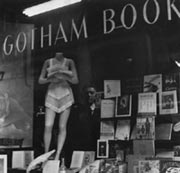
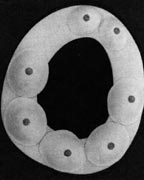
Footnote 34.1
Marcel Duchamp, Lazy Hardware, 1945
Footnote 34.2
Marcel Duchamp, For Sitting Only, 1957
34. This second study for Given depicts a waterfall running through the legs of headless female, leading Duchamp scholar Herbert Molderings to the conclude that Duchamp first perceived of Given‘s Figure as a pisseuse, standing upright. To him, therefore, another shop window of 1945 is of crucial importance: Duchamp’s installation for Breton’s Arcane 17 at the Gotham Book Mart in April (conversation with the author, November 24, 2001). Within the window, Duchamp uses a mannequin to whose bare leg a faucet is attached. In this respect, Duchamp’s little-known wedding gift to Julien and Jean Levy becomes more significant. For Sitting Onlywas presented at the wedding on January 20th, 1957, in Bridgewater, Connecticut. It is a toilet seat to which seven falsies – nipples painted pink – are affixed, leaving space for the legs of the “sitter.” The falsies, of course, were the same ones used in collaboration with Enrico Donati for the deluxe edition of Le Surréalisme en 1947 (for a first reproduction and brief description of the work, see: Jennifer Gough-Cooper and Jacques Caumont, “Ephemerides,” n. pag. [20 January 1957]).
click to enlarge
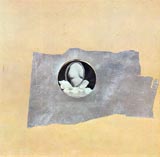
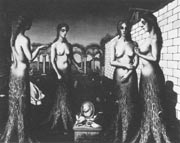
Footnote 35.1
Marcel Duchamp, In the Manner of Delvaux, 1942
Footnote 35.2
Paul Delvaux, In the Manner of Delvaux, 1942
35. In a telephone conversation with Michel Waldberg (see footnote 11), the son of the artist is convinced that the lost sculpture was one of his mother’s, suggesting that Duchamp might have chosen it because of the likeness to what he secretly had in mind. The material used in Waldberg’s sculpture cannot be clearly defined, however. Hans Christoph von Tavel’s Isabelle Waldberg: Skulpturen 1943-1980 (Bern: Kunstmuseum Bern, 1981 [exh. cat.]) states that all of her New York “constructions” were made of bent twigs, with wire “constructions” only appearing in her oeuvre upon Waldberg’s return to Europe in 1946 (p. 10). Both wire and wood would have suited Duchamp well. Given‘s torso rests on tree branches and he often referred to the Bride in his Large Glass as “arbor type”, with its roots in “the skeletal part of the bride” (see: Michel Sanouillet and Elmer Peterson (eds.), The Writings of Marcel Duchamp, New York: Da Capo, 1989, pp. 42, 43). Already in 1942, Duchamp had made the small collage In the Manner of Delvaux, showing a female breast appearing in a mirror. This image itself was a detail appropriated from Paul Delvaux’s painting Dawn, 1937, in which four women, naked from the waist up, seem to emerge from solid tree trunks (see Arturo Schwarz,Complete Works, p. 224).
 36. from: Marcel Duchamp: In the Infinitive – A Typotranslation by Richard Hamilton and Ecke Bonk of Marcel Duchamp’s White Box, Northend: The Typosophic Society, 1999, pp.5-6 (translated from the French by Jackie Matisse, Richard Hamilton and Ecke Bonk).
36. from: Marcel Duchamp: In the Infinitive – A Typotranslation by Richard Hamilton and Ecke Bonk of Marcel Duchamp’s White Box, Northend: The Typosophic Society, 1999, pp.5-6 (translated from the French by Jackie Matisse, Richard Hamilton and Ecke Bonk).
Figs. 1-3, 6, 8, 9, Footnote2
©2002 Succession Marcel Duchamp, ARS, N.Y./ADAGP, Paris. All rights reserved.
Figs. 12-14, 16-18, 20
©2002 Succession Marcel Duchamp, ARS, N.Y./ADAGP, Paris. All rights reserved.
Figs. 24-29, Footnote18
©2002 Succession Marcel Duchamp, ARS, N.Y./ADAGP, Paris. All rights reserved.
Figs. 30, 32-34, 36-38
©2002 Succession Marcel Duchamp, ARS, N.Y./ADAGP, Paris. All rights reserved.
Figs. 39-42, Footnote 34, 35
©2002 Succession Marcel Duchamp, ARS, N.Y./ADAGP, Paris. All rights reserved.












